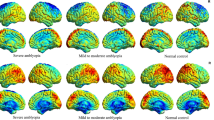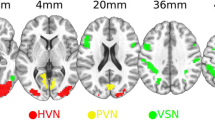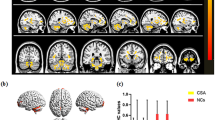Abstract
Purpose
To detect the altered spontaneous brain activity patterns in children and adults with anisometropic amblyopia using resting-state functional magnetic resonance imaging (rs-fMRI) technique combined with the amplitude of low-frequency fluctuation (ALFF) method.
Methods
Thirty-two monocular anisometropic amblyopia and 34 normal-sight controls were divided into child group and adult group. Rs-fMRI was performed in all participants and analysis of ALFF value within the whole brain was conducted in each subject. ALFF value differences between the patients and controls in the two groups were compared via an independent two-sample t test.
Results
The amblyopic children mainly exhibited increased ALFF in part of the bilateral calcarine (BA17), the left middle occipital gyrus (BA18/19), and the left postcentral gyrus (BA2). By contrast, the amblyopic adults showed decreased ALFF in the bilateral precuneus cortex (part of BA7), and the standardized ALFF value of bilateral precuneus were correlated with the amount of anisometropia of the amblyopic adults.
Conclusions
Rs-fMRI is an effective noninvasive technique for exploring brain activity of the anisometropic amblyopia. Our findings demonstrated that brain activity changed both in amblyopic children and adults under the resting state, and revealed the differences in spontaneous activity patterns between the amblyopic children and adults.



Similar content being viewed by others
Abbreviations
- fMRI:
-
Functional magnetic resonance imaging
- rs-fMRI:
-
Resting-state functional magnetic resonance imaging
- BOLD:
-
Blood oxygenation level dependent
- ALFF:
-
Amplitude of low-frequency fluctuation
- ReHo:
-
Regional homogeneity
- BA:
-
Brodmann area
References
McKee SP, Levi DM, Movshon JA (2003) The pattern of visual deficits in amblyopia. J Vis 3:380–405. doi:10.1167/3.5.5
Birch EE (2013) Amblyopia and binocular vision. Prog Retin Eye Res 33:67–84. doi:10.1016/j.preteyeres.2012.11.001
West S, Williams C (2011) Amblyopia. BMJ Clin Evid Jun 30. pii: 0709
Holmes JM, Lazar EL, Melia BM, Astle WF, Dagi LR, Donahue SP, Frazier MG, Hertle RW, Repka MX, Quinn GE, Weise KK, Pediatric Eye Disease Investigator G (2011) Effect of age on response to amblyopia treatment in children. Arch Ophthalmol 129:1451–1457. doi:10.1001/archophthalmol.2011.179
Mendola JD, Conner IP, Roy A, Chan ST, Schwartz TL, Odom JV, Kwong KK (2005) Voxel-based analysis of MRI detects abnormal visual cortex in children and adults with amblyopia. Hum Brain Mapp 25:222–236. doi:10.1002/hbm.20109
Xiao JX, Xie S, Ye JT, Liu HH, Gan XL, Gong GL, Jiang XX (2007) Detection of abnormal visual cortex in children with amblyopia by voxel-based morphometry. Am J Ophthalmol 143:489–493. doi:10.1016/j.ajo.2006.11.039
Du H, Xie B, Yu Q, Wang J (2009) Occipital lobe’s cortical thinning in ametropic amblyopia. Magn Reson Imaging 27:637–640. doi:10.1016/j.mri.2008.10.009
Ogawa S, Lee TM, Kay AR, Tank DW (1990) Brain magnetic resonance imaging with contrast dependent on blood oxygenation. Proc Natl Acad Sci U S A 87:9868–9872
Hess RF, Thompson B, Gole G, Mullen KT (2009) Deficient responses from the lateral geniculate nucleus in humans with amblyopia. Eur J Neurosci 29:1064–1070. doi:10.1111/j.1460-9568.2009.06650.x
Thompson B, Villeneuve MY, Casanova C, Hess RF (2012) Abnormal cortical processing of pattern motion in amblyopia: evidence from fMRI. NeuroImage 60:1307–1315. doi:10.1016/j.neuroimage.2012.01.078
Conner IP, Odom JV, Schwartz TL, Mendola JD (2007) Retinotopic maps and foveal suppression in the visual cortex of amblyopic adults. J Physiol 583:159–173. doi:10.1113/jphysiol.2007.136242
Biswal B, Yetkin FZ, Haughton VM, Hyde JS (1995) Functional connectivity in the motor cortex of resting human brain using echo-planar MRI. Magnetic Resonance Med: Off J Soc Magnetic Resonance Med/Soc Magnetic Resonance in Med 34:537–541
Cordes D, Haughton VM, Arfanakis K, Wendt GJ, Turski PA, Moritz CH, Quigley MA, Meyerand ME (2000) Mapping functionally related regions of brain with functional connectivity MR imaging. AJNR Am J Neuroradiol 21:1636–1644
Kiviniemi V, Kantola JH, Jauhiainen J, Tervonen O (2004) Comparison of methods for detecting nondeterministic BOLD fluctuation in fMRI. Magn Reson Imaging 22:197–203. doi:10.1016/j.mri.2003.09.007
van den Heuvel MP, Mandl RC, Kahn RS, Hulshoff Pol HE (2009) Functionally linked resting-state networks reflect the underlying structural connectivity architecture of the human brain. Hum Brain Mapp 30:3127–3141. doi:10.1002/hbm.20737
Patriat R, Molloy EK, Meier TB, Kirk GR, Nair VA, Meyerand ME, Prabhakaran V, Birn RM (2013) The effect of resting condition on resting-state fMRI reliability and consistency: a comparison between resting with eyes open, closed, and fixated. NeuroImage 78:463–473. doi:10.1016/j.neuroimage.2013.04.013
Damoiseaux JS, Rombouts SA, Barkhof F, Scheltens P, Stam CJ, Smith SM, Beckmann CF (2006) Consistent resting-state networks across healthy subjects. Proc Natl Acad Sci U S A 103:13848–13853. doi:10.1073/pnas.0601417103
Yu C, Liu Y, Li J, Zhou Y, Wang K, Tian L, Qin W, Jiang T, Li K (2008) Altered functional connectivity of primary visual cortex in early blindness. Hum Brain Mapp 29:533–543. doi:10.1002/hbm.20420
Ding K, Liu Y, Yan X, Lin X, Jiang T (2013) Altered functional connectivity of the primary visual cortex in subjects with amblyopia. Neural Plasticity 2013:612086. doi:10.1155/2013/612086
Lin X, Ding K, Liu Y, Yan X, Song S, Jiang T (2012) Altered spontaneous activity in anisometropic amblyopia subjects: revealed by resting-state FMRI. PLoS One 7, e43373. doi:10.1371/journal.pone.0043373
Wang T, Li Q, Guo M, Peng Y, Li Q, Qin W, Yu C (2014) Abnormal functional connectivity density in children with anisometropic amblyopia at resting-state. Brain Res 1563:41–51. doi:10.1016/j.brainres.2014.03.015
Zang YF, He Y, Zhu CZ, Cao QJ, Sui MQ, Liang M, Tian LX, Jiang TZ, Wang YF (2007) Altered baseline brain activity in children with ADHD revealed by resting-state functional MRI. Brain Dev 29:83–91. doi:10.1016/j.braindev.2006.07.002
Bing X, Ming-Guo Q, Ye Z, Jing-Na Z, Min L, Han C, Yu Z, Jia-Jia Z, Jian W, Wei C, Han-Jian D, Shao-Xiang Z (2013) Alterations in the cortical thickness and the amplitude of low-frequency fluctuation in patients with post-traumatic stress disorder. Brain Res 1490:225–232. doi:10.1016/j.brainres.2012.10.048
Cui Y, Jiao Y, Chen YC, Wang K, Gao B, Wen S, Ju S, Teng GJ (2014) Altered spontaneous brain activity in type 2 diabetes: a resting-state functional MRI study. Diabetes 63:749–760. doi:10.2337/db13-0519
Wang Z, Yan C, Zhao C, Qi Z, Zhou W, Lu J, He Y, Li K (2011) Spatial patterns of intrinsic brain activity in mild cognitive impairment and Alzheimer’s disease: a resting-state functional MRI study. Hum Brain Mapp 32:1720–1740. doi:10.1002/hbm.21140
Yan L, Zhuo Y, Wang B, Wang DJ (2011) Loss of coherence of low-frequency fluctuations of BOLD FMRI in visual cortex of healthy aged subjects. Open Neuroimaging J 5:105–111. doi:10.2174/1874440001105010105
Society CO (2011) Expert consensus on amblyopia diagnosis (2011). Chinese J Ophthalmol 47:768
Chao-Gan Y, Yu-Feng Z (2010) DPARSF: a MATLAB toolbox for “pipeline” data analysis of resting-state fMRI. Front Syst Neurosci 4:13. doi:10.3389/fnsys.2010.00013
Han Y, Lui S, Kuang W, Lang Q, Zou L, Jia J (2012) Anatomical and functional deficits in patients with amnestic mild cognitive impairment. PLoS One 7, e28664. doi:10.1371/journal.pone.0028664
Song XW, Dong ZY, Long XY, Li SF, Zuo XN, Zhu CZ, He Y, Yan CG, Zang YF (2011) REST: a toolkit for resting-state functional magnetic resonance imaging data processing. PLoS One 6, e25031. doi:10.1371/journal.pone.0025031
Li C, Cheng L, Yu Q, Xie B, Wang J (2012) Relationship of visual cortex function and visual acuity in anisometropic amblyopic children. Int J Med Sci 9:115–120
Wang X, Cui D, Zheng L, Yang X, Yang H, Zeng J (2012) Combination of blood oxygen level-dependent functional magnetic resonance imaging and visual evoked potential recordings for abnormal visual cortex in two types of amblyopia. Mol Vis 18:909–919
Barrett BT, Bradley A, Candy TR (2013) The relationship between anisometropia and amblyopia. Prog Retin Eye Res 36:120–158. doi:10.1016/j.preteyeres.2013.05.001
Negyessy L, Nepusz T, Kocsis L, Bazso F (2006) Prediction of the main cortical areas and connections involved in the tactile function of the visual cortex by network analysis. Eur J Neurosci 23:1919–1930. doi:10.1111/j.1460-9568.2006.04678.x
Avillac M, Deneve S, Olivier E, Pouget A, Duhamel JR (2005) Reference frames for representing visual and tactile locations in parietal cortex. Nat Neurosci 8:941–949. doi:10.1038/nn1480
Cavanna AE, Trimble MR (2006) The precuneus: a review of its functional anatomy and behavioural correlates. Brain: J Neurol 129:564–583. doi:10.1093/brain/awl004
Muckli L, Kiess S, Tonhausen N, Singer W, Goebel R, Sireteanu R (2006) Cerebral correlates of impaired grating perception in individual, psychophysically assessed human amblyopes. Vis Res 46:506–526. doi:10.1016/j.visres.2005.10.014
Grant S, Melmoth DR, Morgan MJ, Finlay AL (2007) Prehension deficits in amblyopia. Invest Ophthalmol Vis Sci 48:1139–1148. doi:10.1167/iovs.06-0976
Lerner Y, Hendler T, Malach R, Harel M, Leiba H, Stolovitch C, Pianka P (2006) Selective fovea-related deprived activation in retinotopic and high-order visual cortex of human amblyopes. NeuroImage 33:169–179. doi:10.1016/j.neuroimage.2006.06.026
Conflict of interest
We certify that all authors have no affiliations with or involvement in any organization or entity with any financial interest (such as honoraria; educational grants; participation in speakers’ bureaus; membership, employment, consultancies, stock ownership, or other equity interest; and expert testimony or patent-licensing arrangements), or non-financial interest (such as personal or professional relationships, affiliations, knowledge or beliefs) in the subject matter or materials discussed in this manuscript.
Author information
Authors and Affiliations
Corresponding author
Additional information
Minglong Liang and Bing Xie are Co-first Author
Electronic supplementary material
Below is the link to the electronic supplementary material.
Supplemental Figure 1
(GIF 934 kb)
Supplemental Figure 2
(GIF 1099 kb)
Supplemental Figure 3
(GIF 1237 kb)
Rights and permissions
About this article
Cite this article
Liang, M., Xie, B., Yang, H. et al. Distinct patterns of spontaneous brain activity between children and adults with anisometropic amblyopia: a resting-state fMRI study. Graefes Arch Clin Exp Ophthalmol 254, 569–576 (2016). https://doi.org/10.1007/s00417-015-3117-9
Received:
Revised:
Accepted:
Published:
Issue Date:
DOI: https://doi.org/10.1007/s00417-015-3117-9




